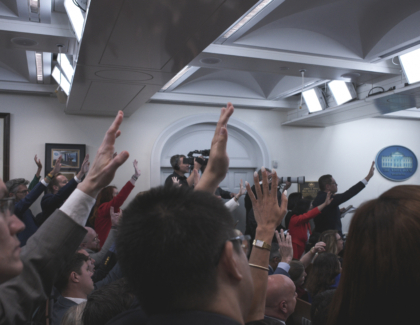Sign up for the daily CJR newsletter.
Talk about a top story. Last week, journalists were on shirt watch as Steve Bannon, the Trump consigliere and right-wing media entrepreneur, went on trial for contempt of Congress after flouting subpoenas from the House committee investigating January 6 and turned up at the courthouse in DC wearing three shirts layered one over the other, even though it was hot out. Vice’s Greg Walters noted that Bannon seemingly wore the same three shirts at least two days in a row, but was unable to confirm this with Bannon, who “ignored a question shouted at him about his sartorial decision-making from the crowd of journalists and onlookers.” On Friday, after Bannon was found guilty, never–Trump cable-news types asked with one voice how many shirts (or jumpsuits) he would be allowed in prison. North Korea’s official news agency even got in on the fun. (No, not really.)
Bannon had tried to delay the trial, arguing that recent committee hearings and a CNN investigation focused on Bannon that aired last week would prejudice potential jurors; he also argued that the judge in the case had unfairly circumscribed his defense, but on the trial went. After prosecutors quickly wrapped their case, Bannon’s lawyers declined to call any witnesses or present any evidence, though they did argue that the subpoenas Bannon defied may not have been real since no one could say for sure that someone hadn’t forged the signature of Bennie Thompson, the committee’s chair, and implied that a committee staffer may have colluded with a prosecutor in the case since they attended the same book club. The judge warned Bannon not to make a “political circus” of the trial, but as Bloomberg’s Erik Larson noted, his edict didn’t make it past the courthouse steps, where Bannon engaged with the media scrum on his way to and from proceedings. On Wednesday, Bannon questioned whether Thompson had really just come down with a case of COVID or whether that was a convenient excuse, even though the judge had already barred Bannon’s team from calling him as a witness. On Friday, following his conviction, Bannon said that he respected the verdict, but pledged to appeal it. “We may have lost a battle here today,” he said, “but we’re not gonna lose this war.”
ICYMI: Brian Lehrer on his climate commitment, and telling relatable stories
Bannon, of course, is not a new media obsession. (Even the shirts thing has been litigated before: New York’s Olivia Nuzzi investigated in 2017, with a spokesperson telling her that Bannon’s multiple shirts prove that “he’s always got a contingency plan.”) The last time I wrote about Bannon at any length in this newsletter he was also in legal hot water: shortly before the 2020 election, he was arrested and charged with misusing funds from a supposed crowdfunder for Trump’s border wall. (Trump would later pardon Bannon on his way out of the White House.) I wrote at the time that it was tempting to see Bannon’s arrest as a coda, of sorts, to his career; his profile had diminished from its early-Trump-era omnipresence, as had the relevance of Breitbart, the right-wing site he had led. I warned, though, that we were still living in the information ecosystem that Bannon had helped create, and that his story wasn’t yet over. A few months later, on January 5, 2021, Bannon twice spoke privately with Trump. In between times, he warned publicly that “all hell” would break loose at the Capitol the next day. It did.
In recent months, Bannon has been the subject of significant mainstream media attention again, due to his interactions with the committee but also due to the influence of War Room, his latest media vehicle, which he mounted in the fall of 2019, as Trump faced his first impeachment, and has since used to pump out industrial-scale disinformation about the election—and thus the country—being stolen. As The Atlantic’s Jennifer Senior wrote in a recent profile of Bannon, War Room is a podcast, though to call it that annoys Bannon, who points to the fact that it broadcasts in video form, too (though not via YouTube, which dumped the show in the wake of January 6). The show “has an amusing shoestring quality to it,” as if “Father Coughlin stumbled into Wayne and Garth’s basement,” Senior wrote. And it “positively burbles with conspiracies, or at least darkly hints at doings within doings, grimy wheels within wheels.”
Importantly, as Senior noted, Bannon isn’t just using War Room to pump out extremist propaganda about the election; he is consciously trying to mobilize his listeners to do something about it, urging them to run for office or seize control of the routine machinery of American elections—a manifestation of the so-called “precinct strategy” that Bannon once called his show’s “whole purpose.” Last year, ProPublica spoke with Republican leaders in sixty-five key counties nationwide, and found that nearly two thirds had observed an “unusual increase” in signups to be precinct officers—numbering into the thousands of people—after Bannon started pushing the idea. On his show, Bannon has regularly interviewed election-denier Republican candidates for higher-level state offices with control over the mechanics of elections, helping them to raise funds. According to CNN’s aforementioned recent Bannon investigation, War Room is “usually among the top three Apple political podcasts in the United States.” David Chalian, CNN’s political director, made the case that Bannon, “right now, in this time, is setting the agenda—even more than Donald Trump.”
Not everyone agrees with that assessment of Bannon’s enduring power—some other commentators view him as a spent force whose influence the mainstream press is wont to overstate. Senior grappled with the question in her profile, asking whether Bannon is “Lenin in Zurich, patiently biding his time,” or “some Estonian anti-Communist émigré from a Le Carré novel, waiting to die in a lonely bedsit in London?” Matthew C. MacWilliams, the author of a book called On Fascism, dismissed Bannon as “Rasputin with a digital show,” adding, “Rasputin was knifed.” “Bannon? Please,” John Podhoretz, the editor of Commentary, told Senior. “He’s not an emperor and he has no clothes.” It may be more accurate to say that what clothes he does have, he wears at the same time.
If the mainstream press has long been fascinated by Bannon (and his sartorial inelegance), Bannon has long been fascinated by the mainstream press; as I wrote back in 2020, he pioneered a dual strategy of mainlining grievance and conspiracy directly to far-right media consumers while also trying to insert his preferred narratives into respectable outlets, a feat he achieved with no little success in 2016. If covering him feels fraught, it’s because one such narrative is that of his own power; in the course of reporting her Bannon profile, Senior wrote, she was warned repeatedly that he was using her to sell a certain image of himself. It seems, though, that Bannon’s vision of institutional capture—or impression of the feasibility thereof—has grown even more extreme over time, shifting from the co-opting of media narratives (scary enough) to the basic architecture of elections. As Senior put it, it’s tempting to dismiss Bannon as “one of those strange id creatures who’s come to sudden prominence in this id-favorable internet age,” but “there’s now loads of room for those id creatures in American politics and culture, and they can accumulate considerable influence.”
Bannon is certainly not a lone fighter in the movement to blow up American democracy: two big new stories about it—a New York Times Magazine profile, by Charles Homans, of the “Stop the Steal” movement and an Axios series, by Jonathan Swan, spelling out Trump’s plan to rip out career bureaucrats and replace them with loyalists—respectively mentioned Bannon in passing and not at all (though Bannon has endorsed the latter idea, including following Swan’s story). And, where Trump and the broader authoritarian right are concerned, the mainstream press has often been too keen to anoint thought leaders, sometimes as a shortcut to understanding movements that are too messy to understand purely as a function of such top-down dynamics. None of this means, though, that Bannon’s platform is small or his influence inconsequential. Indeed, even if Bannon’s platform were much smaller, his influence might be sizable given how few people it takes to rock democracy to its core. We saw that on January 6.
Bannon has not always been able to follow through on his direst threats: he pledged to resort to “medieval” tactics during his recent trial, but “instead of raising hellfire,” as Vice’s Walters noted, he “fell back on his signature move: create a crap-cloud of confusion.” In general, though, confusion is dangerous enough, even if it fell flat as a legal strategy in his case. And—while it would be a stretch to believe that Bannon is excited about going to jail, despite his blasé statements about the prospect on Fox—his conviction is already allowing him to play another role that brings both attention and influence within the right-wing media and political ecosystem that he helped build. As Joyce Vance, a lawyer and liberal pundit, put it last week, Bannon’s many shirts were a “good indication he’s treating this as theater and relishing the prospect of martyrdom.”
Below, more on Steve Bannon and January 6:
- Keeping up with Jones: Since his conviction Friday, Bannon has continued to host War Room. On Saturday, he invited on the conspiracy theorist Alex Jones and the pair lavished praise on each other, with Jones hailing Bannon for showing “the most courage of anybody out there standing up to the January 6 fraud and really bringing America back,” and Bannon hailing Jones as one of the greatest political thinkers since the founding. Relatedly, over the weekend, Tiffany Hsu, of the Times, explored Jones’s ties to the Genesis Communications Network, a radio network founded by a precious-metals merchant in Minnesota, and how they illustrate “the economics of misinformation.”
- Kin-folk: The Washington Post’s Paul Kane profiled Rep. Adam Kinzinger, one of just two Republicans serving on the January 6 committee, charting his journey from GOP rising star to heretic. (Kinzinger will leave Congress at the end of this term.) “On the Jan. 6 committee, Democrats lean on him to explain right-wing media so certain issues can be tamped down before they turn into conservative feeding frenzies,” Kane writes. Jamie Raskin, a Democrat on the committee, told Kane that while “nobody understands the GOP power structure better than Liz Cheney,” the committee’s other Republican, “nobody understands the right-wing media infrastructure better than Adam Kinzinger.”
- (Another) disavowal: After the January 6 hearings got underway last month, the editorial boards of the Wall Street Journal and the New York Post, both Murdoch-owned papers, started to turn on Trump, with the former accusing Trump of betraying his supporters and the latter suggesting that readers should move past the former president. Last week, after the hearings concluded (at least for now), the two editorial boards were critical again. The Journal’s wrote that Trump failed a test of character on January 6, while the Post’s described Trump’s inaction that day as “damning” and inexcusable.
- Doing your job, Merrick Garland?: Last week, Lawfare convened a (written) debate, with different editors taking different positions on the question of whether Merrick Garland, the attorney general, is moving swiftly enough to hold Trump accountable for trying to overthrow the election. Quinta Jurecic and Natalie K. Orpett argued that he is not, and that it’s “reasonable at this point for the public to be frustrated by, and for journalists and commentators to start pushing on, the Justice Department’s continuing silence and apparent lack of urgency regarding Trump’s personal criminal culpability.” Their colleague Benjamin Wittes disagreed, arguing that it is too soon to judge Garland.
Other notable stories:
- After its draft opinion overturning Roe v. Wade leaked to Politico, the Supreme Court announced a leak probe, but the court has since gone silent, the AP’s Mark Sherman writes. It won’t say whether the leaker has been identified or disciplined, “or whether an outside law firm or the FBI has been called in. Or whether the court will ever offer an accounting of what transpired. Or whether it has taken steps to try to prevent a repeat.”
- The Washington Post’s Erik Wemple eviscerated Lis Smith, a Democratic operative and author of a new book, over inconsistencies in her account of her work for the disgraced former New York governor Andrew Cuomo, from whom she is now seeking to distance herself. Wemple characterized Smith’s account as “a résumé-cleansing epiphany in a world where performing pit-bull PR work for a #MeToo casualty isn’t a sought-after credential.”
- After downgrading its rating for FoxNews.com from “green” to “red” last week, NewsGuard, a company that assesses the credibility of news sites, also downgraded MSNBC.com, ruling that the latter site does not meet its standards for responsibly gathering information or delineating news and opinion, issuing corrections, and disclosing “who’s in charge.” MSNBC has yet to comment on NewsGuard’s conclusions.
- Recurrent Ventures, a venture equity-funded digital-media company, shut down MEL magazine just a year after reviving the site. On Friday, management laid off the site’s entire editorial staff during a virtual meeting, then kicked the staffers out of the meeting and immediately deactivated their company email accounts, Insider reports. A staffer said they were “shocked,” and called the layoffs “chaotic” and “clearly last-minute.”
- Researchers at Avast, a cybersecurity company, “linked the discovery of an actively exploited but since-fixed zero-day vulnerability in Google Chrome to an Israeli spyware maker targeting journalists in the Middle East,” TechCrunch reports. The firm in question, Candiru, sells spyware to government clients for what it claims are lawful reasons, but its product was used to surveil staffers at a news agency in Lebanon, Avast found.
- After being banned in much of Europe and Canada after Russia invaded Ukraine, RT, the Kremlin-backed broadcaster, is in the process of setting up its first bureau in Africa, seeking, Bloomberg’s Antony Sguazzin reports, “to entrench support in a continent that’s largely refrained from criticizing” the invasion. RT initially planned to base its African operation in Nairobi, Kenya, but will instead launch out of South Africa, Sguazzin writes.
- Last week, the United Nations’ aviation agency formally blamed the government of Belarus for using a hoax bomb threat, last year, to ground a flight carrying Roman Protasevich, an exiled Belarusian journalist who was arrested after the plane landed. The agency characterized the hoax as “an act of unlawful interference.” (For more on Protasevich and journalism in Belarus, read Charles McPhedran in CJR.)
- Also last week, La Prensa, a newspaper in Nicaragua, announced that its staff has fled the country and will now work from exile; the authorities had recently arrested two of the paper’s employees, intensifying a longer-term campaign of repression against it. Authorities also recently raided and shuttered Trinchera de la Noticia, another independent outlet. (For more background, read Charles Davis’s 2018 article for CJR.)
- And The Observer’s Tim Adams bade farewell to the Saturday evening Sports Mail in the English city of Portsmouth—the last remaining British local newspaper dedicated to covering the day’s sporting action as soon as it concluded. Such papers were born, in the eighteen hundreds, from publishers’ desire to utilize the “hour between matches ending and pubs opening,” Adams writes. Their cause of death? The internet.
ICYMI: The January 6 committee revolutionizes democratic storytelling
Has America ever needed a media defender more than now? Help us by joining CJR today.







